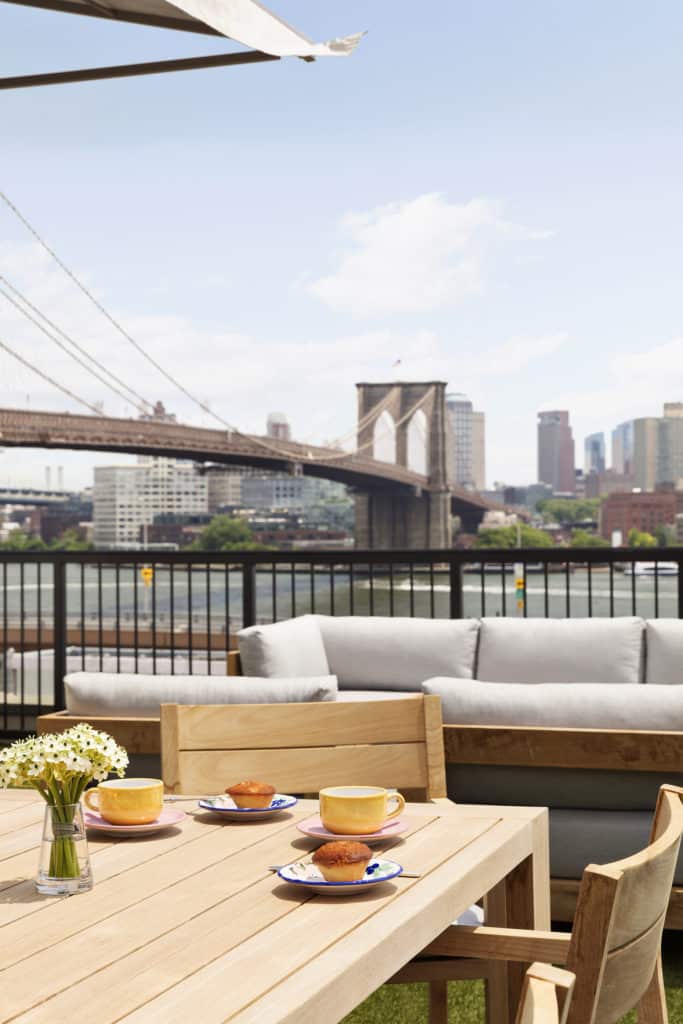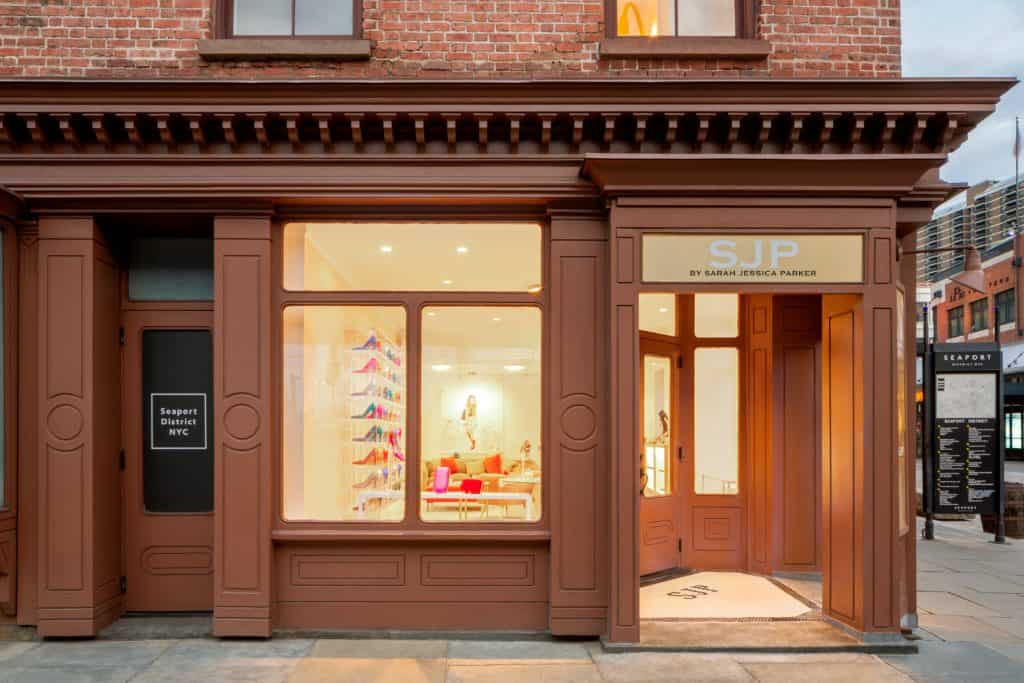Looking for a quick day trip or even a weekend getaway? The Seaport District in Manhattan, where Fulton Street meets the East River, could be the surprising answer.
It’s not a mall; it’s a mecca. “The Seaport District is a radical departure from the old South Street Seaport that was full of cookie cutter tourist traps and t-shirts,” says Jessica Lappin, president, Alliance for Downtown New York. “It’s now a place where real New Yorkers and people in the know can go to have a memorable meal with outstanding views of the waterfront.” The rebranded Seaport District is about destination dining, fashion, and entertainment with a dose of culture and history.
The Seaport has had its ups and down ever since the Dutch West India Company established the first pier there in 1625. It was a thriving commercial hub until ships got too big for its relatively shallow waters and moved on. The Fulton Fish Market supplied New York’s fish for years until it moved to the Bronx. For some time, the area was a tacky tourist attraction eschewed by locals. Finally, Superstorm Sandy all but drowned it.
There were fears that the area would never recover from the devastation caused by Sandy. But it has enjoyed a remarkable recovery and the revitalization goes on and on. The Howard Hughes Corporation signed a ground lease with the city of New York in 2010 and poured $600 million into the redevelopment.

First up was the luxury i-Pic theater which offers reserved seating with waiter service as well as the Tuck Room, a full restaurant and bar upstairs. Marquee chefs started pouring in. On Pier 17, Jean-Georges Vongerichten opened the waterfront seafood restaurant called The Fulton. “It’s the sexiest menu we have in New York City,“ he says proudly on a video he made for the Alliance and notes that about 90 percent of his customers are local.
David Chang opened Bar Wayo. Helene Henderson introduced the California cuisine she made popular on another pier at Malibu Farm. Andrew Carmellini will open an Italian chophouse soon. Perhaps most ambitious of all, Jean-Georges, who waxes nostalgic about shopping at the Fulton Fish market at 4 a.m. when he was a newbie, will open a gigantic food hall in the rebuilt Tin Building next year. Plans call for a seafood shop and a number of mini-restaurants. A rooftop venue offers ice skating in the winter and concerts in the summer — all fueled by craft cocktails.
Carrie Bradshaw wannabes shop for stilettos at SJP and occasionally might even catch a glimpse of Sarah Jessica Parker herself. Fashionistas seek out avant garde get-ups at Cynthia Rowley or 10 Corso Como, an outpost of Milan’s all-encompassing concept store that includes a restaurant, and an art gallery exhibiting Bruce Gilden “Lost and Found” photos through April 5.
Locavores shop at Fulton Stall Market, a relatively small indoor farmer’s market with a Sunday outdoor location in warmer months. It’s billed as the first step toward the development of a “year round indoor public market featuring locally grown and produced food.” Farmers’ markets are particularly appealing to locals and there are now 62,000 residents living below Chambers Street in lower Manhattan.

Book lovers hang out at McNally Jackson, the wildly successful independent bookstore that captured the millennial Zeitgeist. I wish the late Nora Ephron was still with us to explain why this store prospers while so many “Shops around the Corner” like the one in “You’ve Got Mail” struggled or failed. Owner Sarah McNally says that the landlord approached her to bring her literary expertise, deep inventory of 60,000 books, and high-end stationery to the revitalized area. “We’ve all been struck by how robust and loyal the neighborhood locals have been,” says assistant manager Madeline Gressel. The store’s café is already filled with the coffee drinking lap-top crowd. Beer and wine coming soon.
There’s even a hotel. Mr. C Seaport, by the Cipriani family, provides a luxury boutique hotel experience with sweeping views of the Brooklyn Bridge and the Manhattan skyline from its upper floors suites with terraces. A chic tone is set immediately at check-in with a welcome Bellini, the peach and Prosecco libation invented by Giuseppe Cipriani at Harry’s Bar in Venice in 1948. The imported Italian lounge chairs upholstered in Armaniesque shades of Bellini peach, creams, and grays provide a comfortable perch especially on Thursday jazz evenings. The adjacent Bellini restaurant offers Italian fare. While the location might seem out of the way compared to say, a midtown hotel, visitors can immerse themselves in the Seaport District or explore all the nearby sites of lower Manhattan such as the 9/11 Memorial and the Oculus. A house car will also whisk them anywhere within 30 blocks. General manager Edorado Minoli says many of the guests are international from Europe, Brazil or Mexico or diplomats who appreciate the European charm. “The Seaport reminds me of London,” says Minoli.

The new Seaport District is a highly curated experience meant to appeal to well-heeled and well-read travelers and New Yorkers with good taste in food. Though there are reasonably priced burgers, tacos, and ice cream in various nooks and crannies, you won’t find a McDonalds here.
What you will find is a sense of old world charm and history on the cobble stone streets. You will also find the largest concentration of 19th century commercial buildings remaining in New York. The South Street Seaport Museum offers a glimpse into the bygone seafaring era and includes tours of historic ships moored in the harbor. It also houses Browne & Co stationers which operates a 19th century style printing press.
At the entrance to the Seaport at Fulton and Pearl Streets stands the 60-foot tall Titanic Memorial Lighthouse dedicated to those who perished in the tragic sinking of the grand ocean liner. The lighthouse was originally mounted atop the old Seaman’s Church Institute. When that building was demolished, it was donated to the South Street Seaport Museum. Right away, it signals to the visitors that they are entering a neighborhood dedicated to historic preservation as well as modern development.
Beverly Stephen, the former executive editor of Food Arts magazine, is the co-owner of Flavor Forays, a culinary travel company.












!['The Maples' is a prestigious generational compound of two extraordinary estates: 18 Maple and 22 Maple. This rare offering, designed by luxury architect Lissoni partners New York and developed by visionaries Alessandro Zampedri-CFF Real Estate and JK Living, redefines opulence with the highest quality of craftsmanship and captivating views of the Atlantic Ocean. Represented by @nycsilversurfer and @challahbackgirl of @douglaselliman. [link in bio]](https://hamptonsrealestateshowcase.com/wp-content/uploads/sb-instagram-feed-images/438891010_1083749139481747_7890082604579275354_nfull.jpg)
![Featuring 360-degree water views on Mecox Bay, the Atlantic Ocean and Channel Pond, 1025 Flying Point offers the ultimate beach cottage that is flooded with natural light. With panoramic views, proximity to the ocean, and a private walkway to Mecox bay for kayaking or paddle boarding, this truly is a special retreat. Represented by @ritcheyhowe.realestate and @hollyhodderhamptons of @sothebysrealty. [link in bio]](https://hamptonsrealestateshowcase.com/wp-content/uploads/sb-instagram-feed-images/438994305_737511778456166_4602476013493875279_nfull.jpg)
![Attention advertisers! 📣 Secure your spot in the highly anticipated Memorial Day edition #HRES. Reach thousands of potential clients and showcase your brand in one of the most sought-after publications in the Hamptons, NYC, Palm Beach, and beyond. Contact us now to reserve your ad space! [link in bio]](https://hamptonsrealestateshowcase.com/wp-content/uploads/sb-instagram-feed-images/438549843_275102939023235_6718257301437562124_nfull.jpg)
![You eat with your eyes, and on the East End, it’s important that what you eat looks just as good as how it tastes. At @rosies.amagansett, the restaurant itself is plenty photo-worthy with blue ceramic tiling and yellow and white striped fabric wallpaper. But for a dish that will light up your photos, head directly to the salmon tartare! [link in bio]](https://hamptonsrealestateshowcase.com/wp-content/uploads/sb-instagram-feed-images/437094269_7296727147115953_1594410326824303644_nfull.jpg)

![We were honored to be the media sponsor for @blackmountaincapital's open house event with @jameskpeyton and @jfrangeskos at 11 Dering Lane in East Hampton! Other sponsors included @landrover, Feline Vodka, @rustikcakestudio, @la_parmigiana, @lahaciendamexicangrill11968, @homesteadwindows, Stone Castle, @talobuilders, and @thecorcorangroup.
A big thank you Carrie Brudner of Black Mountain Capital for putting together this fabulous event! [link in bio]](https://hamptonsrealestateshowcase.com/wp-content/uploads/sb-instagram-feed-images/437081213_762912965932136_6847332836522786568_nfull.jpg)

![Blooms Galore at the Long Island Tulip Festival! 🌷✨ Mark your calendars for April 15th as the vibrant tulips at @waterdrinkerlongisland burst into full bloom! Enjoy a day filled with colorful splendor, food trucks, live music, and more. [link in bio]](https://hamptonsrealestateshowcase.com/wp-content/uploads/sb-instagram-feed-images/437083429_974242677583725_6855805712693638343_nfull.jpg)
